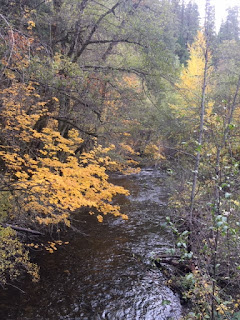It's easy to remember, every spring, how beautiful the woods can be with the colorful glory of wildflowers under the trees and in the meadows. But I forget, every autumn, that while alders and maples hog the spotlight with their fiery yellows and reds overhead, deep on the dark forest floor another kind of flora is pushing up through mud and leaf mold to spot the earth with color. Mushrooms are autumn's answer to spring's wildflowers.
Whereas spring bursts into bloom with neon intensity, mushrooms take hues more appropriate to the woods and to the closing days of autumn—cantaloupe, mauve, leaf-brown, pumpkin—but they are no less startling for having more subtlety. And, anyway, sometimes they aren't so subtle. Slick, white mushrooms are such a contrast with the black soil of their birthing bed they elicit exclamations equal to those emitted at the sight of a field of lupine at the base of a snow-capped mountain.
An amanita, red with white spots, round as a dessert plate; those large, yellow, spongy-looking mushrooms; the little brown ones running around on the ground like a flock of baby birds—purple mushrooms, blue ones, orange ones—the hues are the same names as those we give to wildflowers and maple leaves, but the chroma is in keeping with autumn: earth-toned, tinged with melancholy, akin to decaying leaves and clouded skies. Beauty of a different kind.
A walk through the woods in November reveals a marvel of variety: curly edges, concave cups, perfect circles, smooth and shiny tops, scabby tops, frilly fans. How did mushrooms manage to find such different ways to present themselves? I kneel to pay homage to the strength of a mushroom as it shoulders its way through dirt, pushing aside rocks and roots, ignoring vines that want to hold it back. Here they come! The mushrooms! Thrusting up from the underworld, full-formed—no need for roots to dig in and leaves to photosynthesize. Here they are! The mushrooms!









